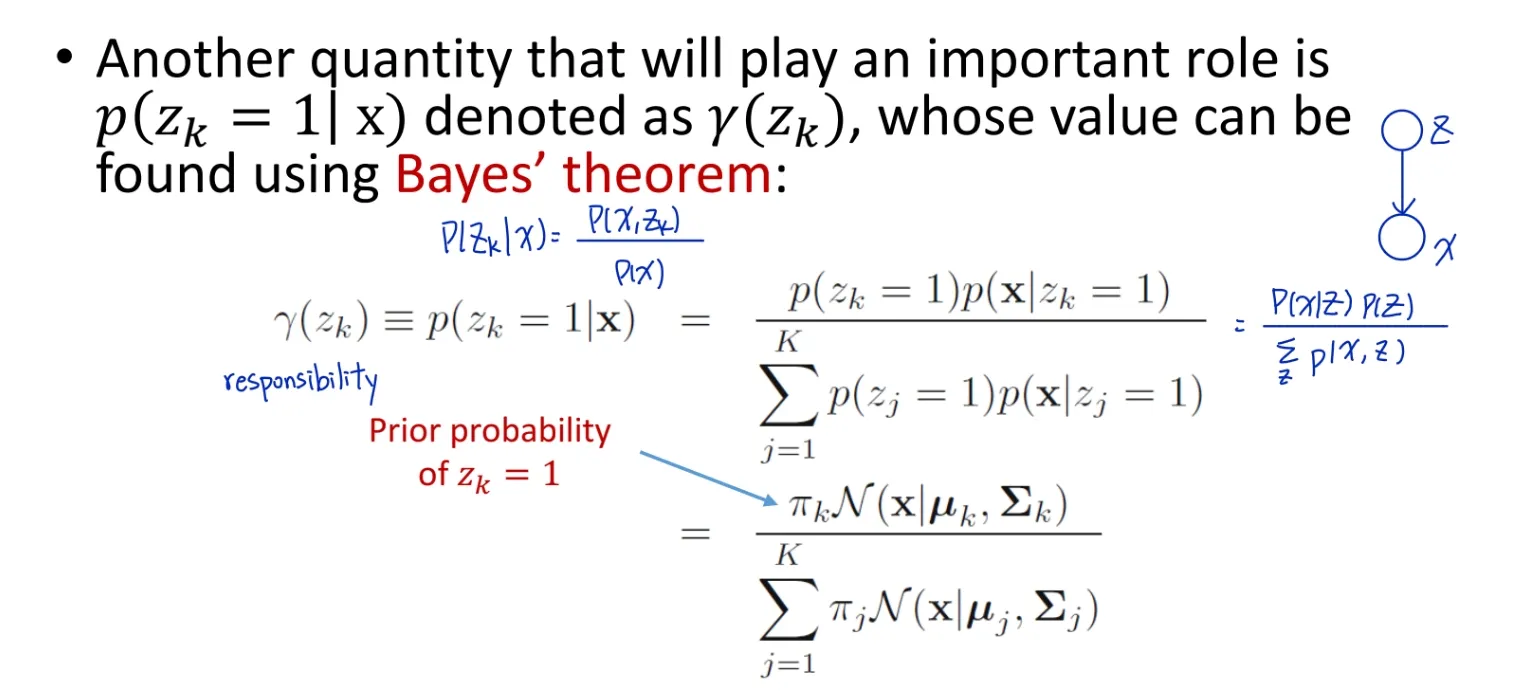Motivation#
- How to find unknown parameters of clusters in unsupervised learning?
- Which cluster does each data belong to?
K- Means Algorithm#
Non-probabilistic, 100% assign to that single cluster
- Given:
- data set {x1,...xN}
- number of clusters K
- Find:
- K cluster centers {μ1,...,μK}
- assign each data x to a cluster center
1-of-K coding:#
- for each data xn, rnk∈0,1 s.t∑Krnk=1
- if data xn is in cluster k, then rnk=1, otherwise 0.
- Hard assignment
- each data is assigned to only 1 cluster
- goal is to minimize J=∑N∑Krnk∣∣xn−μk∣∣2 s.t∑krnk=1
Algorithm:#
- Initialization: randomly choose {μk}
- Assignment: fixed {μk}, minimize J w.r.t {rnk}
- argminrn∑Krnk∣∣xn−μk∣∣2 s.t∑krnk=1
- Update: fixed {rnk}, minimize J w.r.t {μk}
- ∂μk∂J=2∑Nrnk(xn−μk)=0
- μk=∑Nrnk∑Nrnkxn (mean of all points assigned to cluster k)
- Repeat step 2 and 3 until converge
Can we use probability to assign? (Soft assignment)
Probabilistic Approach#
Gaussian Mixture Model#
- linear superposition of multiple Gaussians
- probability distribution:
- p(x)=∑KπKN(x∣μK,∑K) (K Gaussians)
- μK: mean
- ∑K: covariance
- ∑KπK=1: mixing coefficient (weight of each Gaussians in the model)
- 1-of-K representation: ZK=1⇒Zj=k=0
- assignment of x to kth Gaussian
- ZK∈{0,1}, ∑KZK=1
- p(z) is categorical distribution
- p(z) ∏KπKZk=catZ[π]
- if Zk=1 (Z is in kth Gaussian), πKZk=πK, 0 otherwise
- 0≤πk≤1,∑KπK=1
- probability of x belonging to each distribution
- p(x∣zk=1)=N(x∣μk,∑k)
⇒p(x∣Z)=∏KN(x∣μk,∑k)Zk - p(x,z)=p(z)p(x∣z)
⇒p(x)=∑Kp(z)p(x∣z)=∑K∏KπKZkN(x∣μK,∑K)Zk=∑KπKN(x∣μK,∑K)
- Responsibility

Maximum log-likelihood#
- we try to get the partial derivative w.r.t μk,∑k,πk
- argmaxθlnp(x1,...,xN∣θ)=argmaxπ,ν,∑∑Nln∑KπKN(xn∣μk,∑k), ∑ is inside ln ⇒ no closed-form
EM for Gaussian Mixtures#
- θ=πk,μk,∑k
- Initialize πk,μk,∑k
- Expectation step: evaluate responsibilies r(Z)
- r(Znk)=∑kπkN(xn∣μk,∑k)πkN(xn∣μk,∑k)
- Maximization step: update πk,μk,∑k
- μk=Nk1∑Nr(Znk)xn
- ∑k=Nk1∑Nr(Znk)(xn−μk)(xn−μk)T
- πk=NNk
- where Nk=∑Nr(Znk)
- Evaluate log-likelihood
- ln p(x∣μ,∑,π)=∑Nln(∑KπKN(xn∣μn,∑n))
- check for convergence
- Can run K_Means before initializing for EM algorithm
General EM algorithm#
- Goal: find maximum likelihood solution for models with latent variables
- ln p(x∣θ)=ln(∑Zp(x,Z∣θ))
- no closed form
- we don’t have complete {X,Z}, we can consider maximize the expected value of p(x,z∣θ) w.r.t p(z∣x,θ)
- Initialize μ,∑,π
- Expectation step
- Expectation Q(θ,θold)=∑Zp(z∣x,θold)ln p(x,z∣θ)=ez∣x,θold[ln p(x,z∣θ)]
- Mazimization step
- θnew=argmaxθQ(θ,θold)=argmaxθ∑Zp(Z∣x,θold)ln p(x,Z∣theta)
- log is now insize ∑ ⇒ closed form
- Check for convergence of either log likelihood or parameter value
- θold←θnew
Theory behind EM algorithm#
- maximize ln p(x∣θ)=ln∑Zp(x,z∣θ) is difficult, we can maximize its lower bound L(q,θ) instead
- lnp(x∣θ)=L(q,θ)+KL(q∣∣p) where
L(q,θ)=∑Zq(z)lnq(z)p(x,z∣theta)
KL(q∣∣p)=−∑Zq(Z)lnq(z)p(z∣x,θ)≥0
